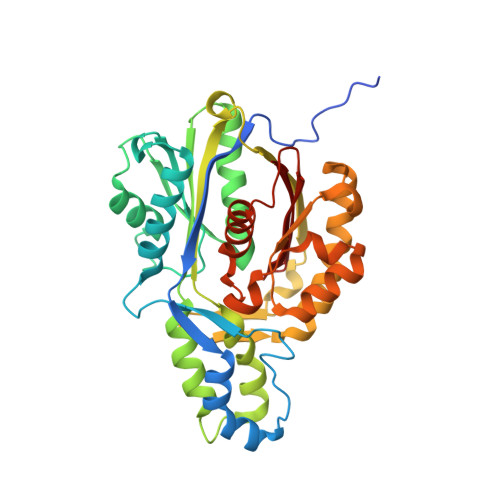OleA Glu117 is key to condensation of two fatty-acyl coenzyme A substrates in long-chain olefin biosynthesis.
Jensen, M.R., Goblirsch, B.R., Christenson, J.K., Esler, M.A., Mohamed, F.A., Wackett, L.P., Wilmot, C.M.(2017) Biochem J 474: 3871-3886
- PubMed: 29025976
- DOI: https://doi.org/10.1042/BCJ20170642
- Primary Citation of Related Structures:
5VXD, 5VXE, 5VXF, 5VXG, 5VXH, 5VXI - PubMed Abstract:
In the interest of decreasing dependence on fossil fuels, microbial hydrocarbon biosynthesis pathways are being studied for renewable, tailored production of specialty chemicals and biofuels. One candidate is long-chain olefin biosynthesis, a widespread bacterial pathway that produces waxy hydrocarbons. Found in three- and four-gene clusters, oleABCD encodes the enzymes necessary to produce cis -olefins that differ by alkyl chain length, degree of unsaturation, and alkyl chain branching. The first enzyme in the pathway, OleA, catalyzes the Claisen condensation of two fatty acyl-coenzyme A (CoA) molecules to form a β-keto acid. In this report, the mechanistic role of Xanthomonas campestris OleA Glu117 is investigated through mutant enzymes. Crystal structures were determined for each mutant as well as their complex with the inhibitor cerulenin. Complemented by substrate modeling, these structures suggest that Glu117 aids in substrate positioning for productive carbon-carbon bond formation. Analysis of acyl-CoA substrate hydrolysis shows diminished activity in all mutants. When the active site lacks an acidic residue in the 117 position, OleA cannot form condensed product, demonstrating that Glu117 has a critical role upstream of the essential condensation reaction. Profiling of pH dependence shows that the apparent p K a for Glu117 is affected by mutagenesis. Taken together, we propose that Glu117 is the general base needed to prime condensation via deprotonation of the second, non-covalently bound substrate during turnover. This is the first example of a member of the thiolase superfamily of condensing enzymes to contain an active site base originating from the second monomer of the dimer.
Organizational Affiliation:
Department of Biochemistry, Molecular Biology, and Biophysics, University of Minnesota, Minneapolis, MN, U.S.A.
















